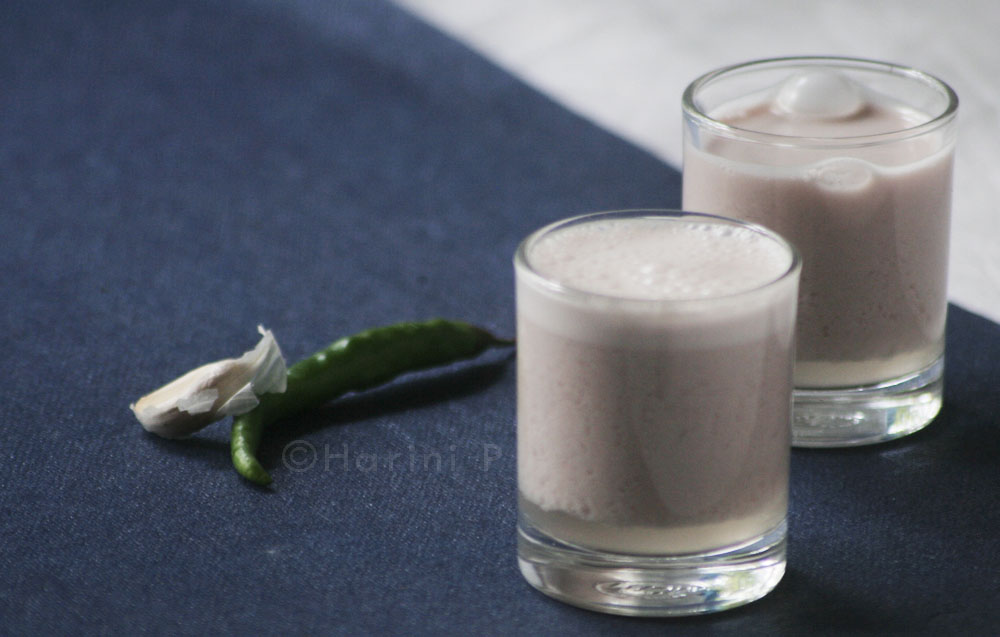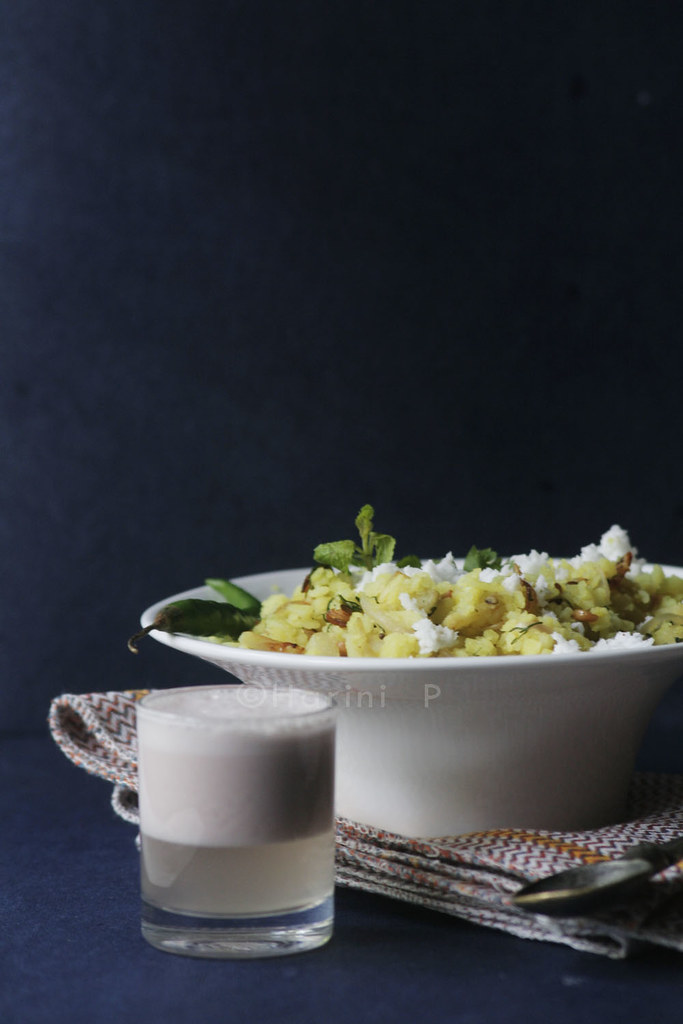Kanda poha with kokum kadhi - A Maharashtrian breakfast
This is my all time favourite Maharashtrian breakfast. It is perfect for lazy, late morning weekends when you want to just cook up something quick and settle down on that couch with your favourite comic strip and a mug of coffee.
There was a time when I had very nearly got tired of this delicacy! Our friend, A was stationed at Shrivardhan, a beautiful, verdant, rustic city along the Konkan region of Coastal Maharashtra. The route to Shrivardhan from Thane is quite mesmerising. It is peppered with virgin beaches and the scent of the sea almost calls you out to the beach even before you have settled in! I remember taking walks early in the morning from our place to the beach just to see the sunrise and repeating this simple pleasure during sunset. It is good to know that you can dig your toes into the cool sand and feel it slipping away, smooth and fast as you pick up your feet without encountering oil or clay. While you are there you must also take time to visit the Harihareshwar Temple close by and take a boat trip in the Arabian Sea if you would like to watch leaping dolphins against the setting sun. What we saw were scenes straight out of a picture postcard! While I discovered and enjoyed the taste of 'solkadhi', my non-veggie friends would eat nothing but fresh sea food like prawns, lobsters and fish!
For a day or two we also stayed at a nearby resort. The resort was reasonably priced but the best part was the breakfast and the appetizers. It was an 'off-season' visit and we being the only residents, the resort did not offer much variety. It was kaanda poha for breakfast, for tiffin and for the next morning's breakfast. We did not expect much but when we asked for something different, the men in the kitchen would just not bother saying that the resort was pretty far from town and they simply could not buy so much and stock - such is service at small cities - but we knew we were having everything fresh and homegrown! The kokum kadhi offered as appetizer was so good that we insisted on having it with every meal and so was the food - they had fresh paneer, pulao and made a lip smacking vangyachya bharit to name a few of the delicacies we ate. Solkadhi or kokum kadhi is charateristic of the Konkan region. Just as Tamilian cuisine makes use of tamarind in gravies for added tang, Konkanis and Maharashtrians use kokum in curries. Recently a friend of P, gifted us a bottle of pure kokum extract. Ever since, P very often prepares kokum kadhi or solkadhi. It is an appetizer and a digestive that takes hardly any time. My friend, Anita, informs me that in her region the kadhi is seasoned with mustard seeds and curry leaves and taken with rice. I enjoy it better as an appetizer. Perhaps it is the same with rasam. While we Tambrahms mix it with rice and have it as part of our mains, most of my North Indian friends prefer having rasam out of a bowl, like soup minus croutons!
Today I had both my favourties together for breakfast - one of those days when the mom needs to cook for her own pleasure:D.
The other dish poha - kaanda pohe - is popular all over India and the method of preparation varies with region. The Maharashtrian method is the quickest and is my family's favourite. Poha is made by flattening dehusked rice into thick or thin flakes. It is amongst the early foods introduced to children. These flakes just need to be immersed in a little water/milk/thin curd to make them softer as they swell and then squeezed. You can use them imaginatively as you wish. Drained poha mixed up with grated jaggery and coconut, or with milk and sugar makes an excellent nutritious snack for young children as well as adults. Poha is known as chivda in Hindi and Aval or avil in Tamil.
Recipe for kaanda pohe or kaanda-batata pohe (Flattened/beaten rice flakes)
Serves: 3 persons
Ingredients:
2 level cups - flattened/beaten rice (poha)
1 medium sized potato
2 medium sized onions sliced thin
2 green chillies slit lengthwise
1 lime to squeeze over the dish just before serving
Salt to taste
Turmeric powder - 1/8 tsp.
 Kanda-batata pohe
Kanda-batata pohe
Seasoning:
2tbsp. oil
1 tsp. mustard seeds/rai
Curry leaves - 1sprig
1tbsp. chopped cashews or raw podded peanuts
Garnishing:
Chopped coriander leaves and a smattering of fresh grated coconut (2tbsp.)
Method:
Use a wide colander to rinse the poha in running tap water and let drain. After five minutes try squeezing some of the flakes between your index finger and thumb. If it still feels firm repeat rinsing and let drain. The rice flakes will swell absorbing some amount of water and will turn soft to touch but they should not be soggy or retain water. After a few minutes sprinkle turmeric and salt to taste.
Cut the potatoes lengthwise and into wedges. Turn them and chop into thin slices. Wash and set aside.
Heat oil in a wok and splutter the mustard seeds followed by green chillies and curry leaves.
Add the cashews and roast till pink. Add onions and caramalize in low fire. Now add potatoes and a pinch of salt. Cover and cook on low heat, stirring in between till the potatoes turn crisp and cooked.
Add the drained poha and mix well to distribute the flavours and turmeric uniformly. Cover and cook for a few minutes, about 4-5 before serving.
Serving:
Serve on a plate garnished with chopped coriander and topped with a tsp. of grated coconut. Squeeze a dash of lime for added tang, if you like.
Recipe for solkadhi or kokum kadhi
Makes 2 tall glasses
 Sokadhi or Kokum kadhi
Sokadhi or Kokum kadhi
3tbsps. of pure kokum extract OR
Soak 8-10 kokum petals in just a quarter glass of water overnight or for 3-4hours and use the water after removing the petals.
1 packed cup freshly grated coconut
About 1 to 1.5 cups plain water
2 green chillies
2 pods garlic - peeled
Method:
Grind the above together and strain out the liquid completely with a muslin cloth.
This can be had as an appetizer. If you wish to have it with rice, heat a tsp. of oil in a seasoning wok, splutter a tsp. of cumin or mustard seeds followed by a few curry leaves and pour into the strained liquid.
Since this contains coconut milk as well, the liquid SHOULD NOT be heated as it will curdle immediately. The appetizer can be had fresh or chilled. If left for 10 to 15 minutes the drink will split into two layers of coconut milk and water which is natural.
Update late into the night:
Consistency of solkadhi should be that of coconut milk. It should be pale pink in colour. The no. of petals of kokum to be used depends on the variety. Sometimes you get the same sourness using just 3 or 4 petals. The taste should not be too sour, but it should have a hint of sourness. Adjust the amount of extract according to your taste adding little be little of the kokum extract.
Some more Maharashtrian delicacies on TONGUE TICKLERS......
Kothimbir Vadi/Coriander Gramflour squares / Thalipeeth / Jhunka or Zunka
Another way with poha - GojavalakkiLabels: Aval, Ing. - Beaten rice, kaanda batata pohe, Kaanda pohe, kadhi, kokumkadhi, Konkan Cuisine, Poha, Pohe, solkadhi, Vegan - Breakfast
